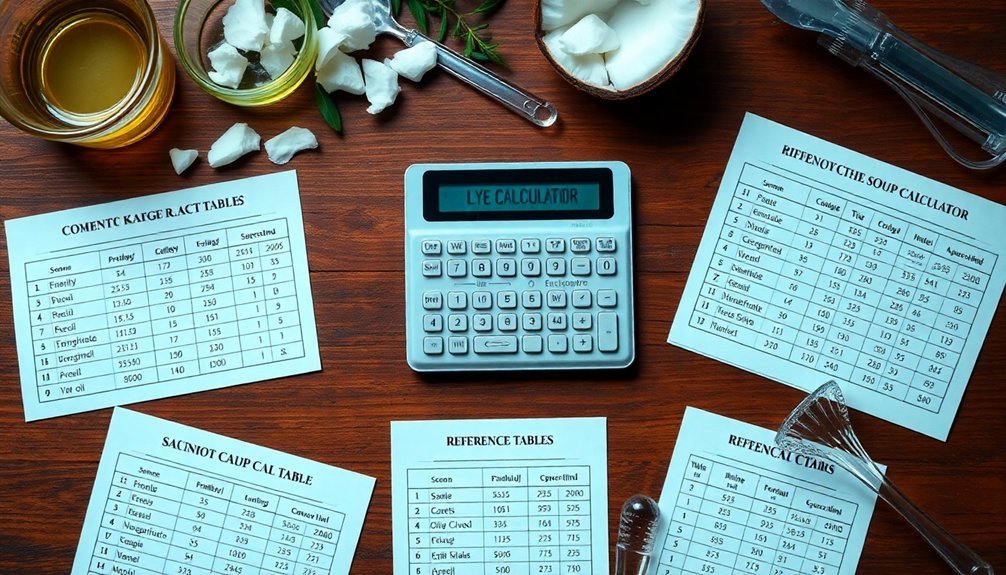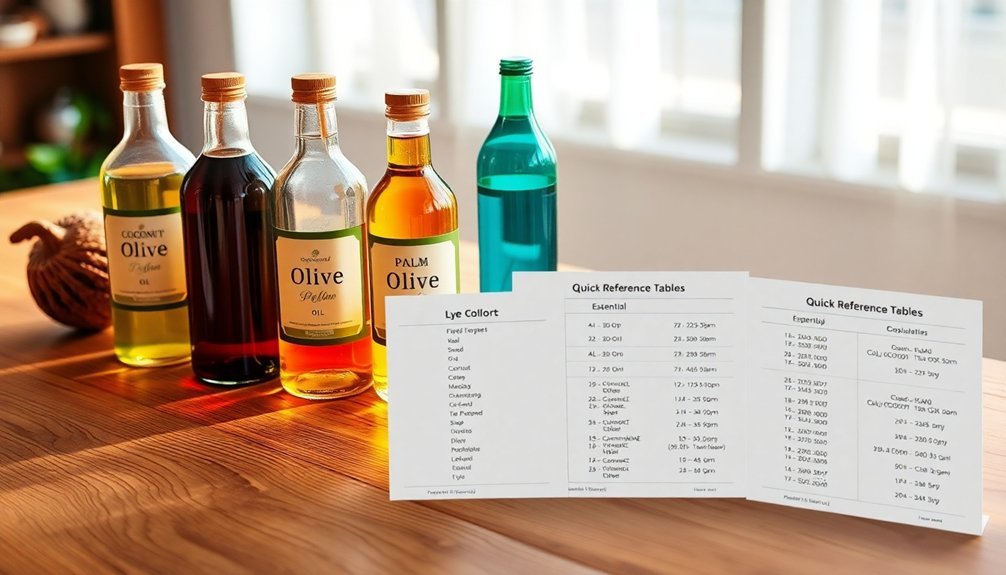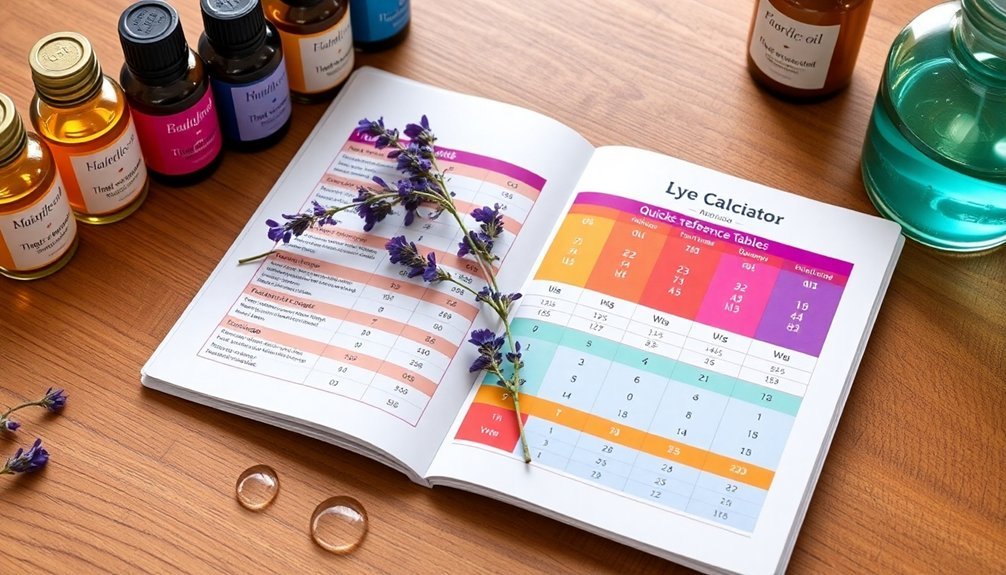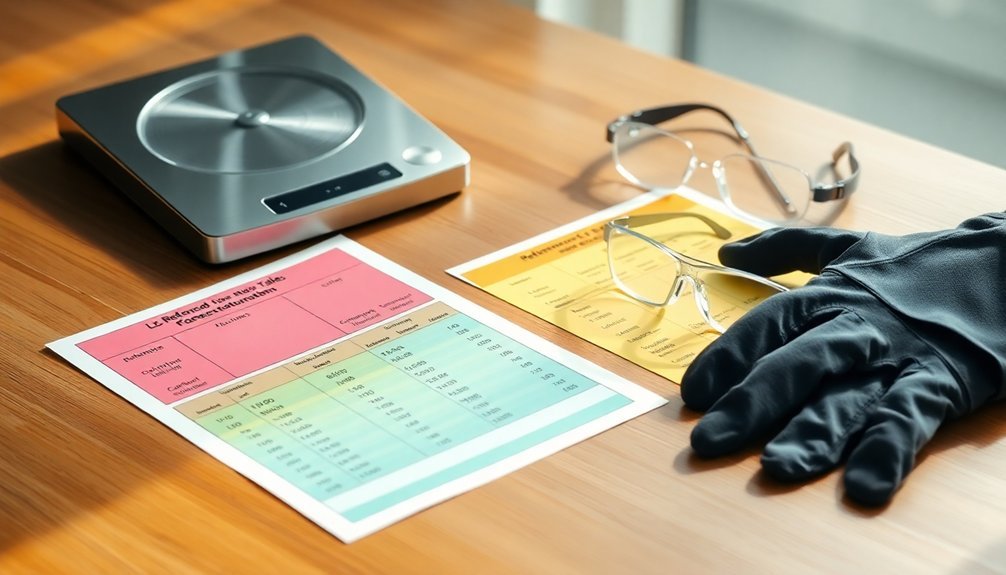Lye soap calculations require precision for safety. You'll need accurate SAP values for your oils (like olive: 189.7, coconut: 268.0), proper water-to-lye ratios (typically 2:1 for bars, 3:1 for liquid), and appropriate superfatting percentages (5-10% for milder soap). Always use a digital scale for measurements and wear protective equipment when handling lye. Online calculators like SoapCalc can verify your numbers, but understanding the fundamentals guarantees safer, successful batches every time.
Lye Soap Calculation Essentials

Precision is the cornerstone of successful soap making. When working with sodium hydroxide, accurate calculations prevent skin irritation from excess lye while ensuring your soap properly solidifies and cleans effectively.
Meticulous measurement isn't just good practice—it's essential protection against the harsh consequences of lye miscalculations.
You'll need to master superfatting—intentionally reducing lye amounts to leave moisturizing oils in your final product. Always use tools like SoapCalc to determine exact sodium hydroxide requirements based on your chosen oils, as each oil demands different amounts. Many online lye calculators are available to help you formulate accurate recipes tailored to your specific oil combinations.
Consider lye concentration and water discount carefully as they directly impact your soap's hardness and lather quality. Remember that all ingredients must be measured precisely—this isn't just about following recipes but ensuring safety and quality.
Before proceeding with any batch, double-check all calculations to protect both yourself and anyone who'll use your soap.
SAP Values Reference Chart
SAP values form the backbone of accurate soap calculations, telling you exactly how much lye is needed to saponify specific oils.
Our reference chart includes common oils like sweet almond (190), avocado (188), and wheatgerm (191), with values expressed in mg KOH per gram of oil.
You'll need to interpret these numbers carefully, converting them appropriately for KOH or NaOH recipes and adjusting for desired superfatting levels. Remember that for solid soap making, you must divide the SAP value by 1402.50 to determine the correct amount of NaOH required per gram of oil.
Basics of SAP Values
Understanding the fundamentals of saponification values is vital for any soap maker venturing into DIY lye calculations. SAP values measure how much lye (sodium hydroxide or potassium hydroxide) is needed to convert a specific oil into soap. They're typically expressed in milligrams of lye per gram of oil.
Each oil has a unique SAP value based on its fatty acid composition. When you're formulating recipes, you'll use NaOH values for bar soaps and KOH values for liquid soaps. Environmental factors like growing conditions and extraction methods can slightly alter these values between batches.
To calculate the amount of lye needed, simply multiply the oil's weight by its SAP value. These calculations are essential for achieving balanced soap formulations that won't irritate the skin.
Remember that precision is imperative—always use digital scales for accurate measurements to guarantee your soap is both effective and safe.
Common Oils Chart
Soap makers rely on accurate saponification (SAP) values to craft balanced, safe formulations. These values tell you precisely how much lye is needed to convert oils into soap. Understanding the SAP values of your ingredients is crucial for calculating the correct amount of sodium hydroxide (NaOH) or potassium hydroxide (KOH).
| Oil Type | SAP Value (mg KOH/g) |
|---|---|
| Coconut Oil | 268.0 |
| Olive Oil | 189.7 |
| Palm Oil | 199.1 |
| Shea Butter | 180.0 |
| Castor Oil | 180.3 |
For NaOH calculations, divide the SAP value by 1402.50. For KOH, divide by 1000. Remember to apply a 5-10% lye discount (superfat) to guarantee your soap isn't harsh on skin. Values may vary slightly depending on the oil source and processing. Always measure ingredients by weight, not volume, for accuracy.
Interpreting SAP Numbers
When you're faced with a chart of saponification values, you'll need to understand what these numbers actually mean for your soap formulation.
These figures represent the milligrams of KOH required to saponify one gram of a specific oil or fat.
To use these values with NaOH (for solid soap), you'll need to convert them by multiplying by 0.71 (the ratio of molecular weights).
Remember that SAP values can vary slightly between sources due to natural oil variations. When reading charts, make sure you're using consistent units throughout your calculations.
For accuracy, always double-check your math and consider using a 5-10% lye discount (superfatting) for milder soap. Accurate measurements using weight, not volume are crucial to ensure your soap turns out as intended.
Document which SAP values you used in each batch to maintain consistency in future recipes.
Water-to-Lye Ratio Tables
Water-to-lye ratios determine your soap's consistency, cure time, and overall quality.
You'll find standard ratios ranging from 3:1 for liquid soaps to 2:1 for faster-curing cold process bars, with each increment affecting trace speed and final hardness.
When using water discounts, remember that higher lye concentrations accelerate saponification but require careful temperature monitoring to guarantee complete lye dissolution. For safety reasons, it's recommended to maintain a minimum 1:1 ratio and always use a reliable lye calculator when adjusting water content.
Standard Soap Ratios
Three essential ratios form the foundation of successful soapmaking, with the water-to-lye proportion being perhaps the most critical for beginners to understand.
Most soap recipes start with a 2:1 water-to-lye ratio as a reliable baseline that works for nearly all applications.
For intricate swirl designs where you'll need more working time, consider increasing to 2.5:1 or even 3:1 ratios.
Conversely, if you're aiming for a firmer bar with faster curing time, try reducing to 1.5:1.
Your recipe's oil composition will influence these ratios considerably.
High olive oil formulations often benefit from lower water ratios (around 1.1:1) to prevent excessive softness, while hot process methods typically require higher ratios to compensate for evaporation during cooking.
Always prioritize safety by wearing proper protective gear when handling lye solutions due to their caustic nature.
Water Discount Effects
Water discount effects represent the next logical step in mastering soap ratios. When you reduce water in your recipe, you'll achieve faster curing times and minimize aesthetic issues like soda ash and glycerin rivers. However, this comes with tradeoffs in design flexibility as trace accelerates. For most beginners, 10% discount provides an optimal balance between faster curing and workability.
| Water Discount Level | Curing Time | Design Impact |
|---|---|---|
| None (33% lye conc.) | 4-6 weeks | Easiest designs |
| Light (35% lye conc.) | 3-5 weeks | Moderate workability |
| Medium (38% lye conc.) | 3-4 weeks | Limited swirls |
| High (40% lye conc.) | 2-3 weeks | Simple designs only |
| Extreme (43%+ conc.) | 1-2 weeks | Risk of undissolved lye |
Your soap calculator should help determine ideal water amounts while balancing additives like purees or milks, which contribute their own moisture. Remember that different oils respond differently—coconut oil soaps benefit more from water discounts than palm-based recipes.
Liquid Soap Considerations
Unlike solid soap formulations, liquid soap creation demands a specialized approach to water-to-lye ratios due to its use of potassium hydroxide (KOH).
Liquid soaps typically require lower lye concentrations—around 10% KOH to 90% water—compared to solid soap's stronger solutions.
When calculating your liquid soap formula, remember that water content directly impacts your final product's consistency.
Too much water results in thin soap, while inadequate water prevents proper hydrolysis.
Always use an online calculator specifically designed for liquid soap to determine precise KOH requirements based on your chosen oils' SAP values.
Your water-to-lye ratio might range from 2:1 to 3:1 depending on your desired viscosity.
Consider adding glycerin to enhance moisturizing properties, but remember this will affect your overall formulation balance and may require adjusting your water content accordingly.
Using a reliable resource like soapcalc.net can make the liquid soap calculation process significantly easier with its detailed oil information and lye type options.
Superfatting Percentage Guidelines
When crafting homemade soap, selecting the right superfatting percentage can dramatically impact your final product's quality and skin benefits.
Most soapmakers start with 5% as a baseline, providing a good balance between moisturizing properties and lather quality.
The 5% superfat sweet spot offers soapmakers the perfect equilibrium between skin-nourishing benefits and abundant, creamy lather.
For everyday body soap, stay within 5-7% range for ideal results. If you're making facial soap, you can use similar percentages for gentle cleansing.
Increase to 15-20% when working with coconut oil-heavy recipes to counter its potentially drying effects.
Keep specialty soaps in mind: laundry soap requires minimal superfatting (1-2%) to prevent machine buildup, while shampoo bars may benefit from slightly higher percentages for conditioning properties.
Remember that higher superfat creates softer bars with less lather but more moisturizing qualities. Testing different superfat levels helps determine your ideal formula, as some oils may develop Dreaded Orange Spots when excessive free oil oxidizes.
Common Oils and Their Properties

Understanding soap oils and their unique characteristics helps you create balanced recipes with desired qualities. Each oil contributes different properties to your final soap bar.
Coconut oil creates rich lather and hard bars but can be drying if overused. Olive oil produces mild, moisturizing soap ideal for sensitive skin with its high oleic acid content. Palm oil adds hardness and stability through its palmitic acid.
For creamy lather with moisturizing benefits, consider castor oil, which is high in ricinoleic acid. Almond oil creates gentle soap with mild cleansing properties.
When designing recipes, balance oils with strong cleansing properties (coconut) against moisturizing ones (olive, castor). Jojoba oil adds a luxurious feel while being exceptionally lightweight and moisturizing.
Remember that oils high in stearic acid will create harder bars, while those rich in oleic acid provide more conditioning but softer soap.
NaOH vs. KOH Conversion Tables
Converting between NaOH and KOH requires you to use the 1.403 ratio factor based on their molecular weights (40 for NaOH and 56.1 for KOH).
You'll need to adjust your calculations further if your lye isn't 100% pure, applying a purity factor to compensate for impurities in commercial lye products.
These conversions are essential when adapting recipes between solid and liquid soap formulations, ensuring your final product achieves proper saponification without excess caustic material. For multi-oil recipes, remember to calculate the total lye requirement by adding the individual lye amounts needed for each oil in your formula.
NaOH vs. KOH Conversion Tables
The two primary alkalis used in soap making—sodium hydroxide (NaOH) and potassium hydroxide (KOH)—require different amounts to saponify the same oils due to their distinct molecular weights.
When you're switching between formulas or creating dual-purpose recipes, you'll need to convert between these two lye types. The simple conversion factor is to multiply NaOH values by 1.403 to get KOH values, or divide KOH values by 1.403 for NaOH amounts. Remember that KOH dissolves much faster in methanol than NaOH, which can affect your production timelines.
| Oil Type | NaOH to KOH Conversion |
|---|---|
| Coconut | NaOH × 1.403 = KOH |
| Olive | KOH ÷ 1.403 = NaOH |
| Shea | NaOH × 40/56.1 = KOH |
| Palm | KOH × 56.1/40 = NaOH |
| General | NaOH:KOH ratio ≈ 1:1.4 |
Purity Factor Adjustments
Accurate soap calculations depend heavily on the actual purity of your lye, which is rarely 100% despite what packaging may claim.
To adjust for this reality, you'll need to calculate your "hidden superfat" (the percentage difference between 100% and your actual lye purity) and incorporate this into your recipe calculations.
For example, if your NaOH is 97% pure, you'll need to divide your calculated lye amount by 0.97 to guarantee proper saponification. Without this adjustment, your soap may end up too soft or harsh.
- Check your NaOH purity by measuring the temperature of a 50% solution—it should reach at least 180°F (82°C)
- Apply the formula: Adjusted lye weight = Original lye weight ÷ Purity (as decimal)
- Remember that KOH typically has lower purity than NaOH and requires its own adjustments
Clumpy NaOH indicates that it has absorbed moisture from the air, which adds water weight and significantly reduces its purity percentage.
Fragrance and Essential Oil Calculator

When creating homemade soaps, properly calculating your fragrance or essential oil amounts guarantees your finished product has the perfect scent intensity without causing skin irritation or other safety issues.
Always calculate fragrance based on your base oils' weight, not the total soap weight. For fragrance oils, use between 3-6% of your base oils' weight depending on desired strength, while essential oils typically require just 1-3%.
Accurate fragrance calculations—measured against base oils only—ensure beautiful scents without safety concerns.
Remember that each essential oil has unique IFRA safety guidelines you'll need to follow.
Many online calculators simplify this process by incorporating IFRA standards automatically. When creating blends, consider how different scents interact before determining your final percentages.
For the safest results, choose fragrance oils specifically formulated for soap making to avoid separation or discoloration in your finished products. Quality fragrance oils are vegan and skin-safe while being free from potentially harmful ingredients like phthalates and parabens.
Colorant Measurement Guide
Proper colorant measurement stands as one of the most critical factors in achieving consistent, professional-looking soaps. For best results, always measure colorants by weight rather than volume, as teaspoon measurements can vary greatly. A general starting point is 1 teaspoon of colorant to 1 tablespoon of oil for cold process soap, but you'll need to adjust based on your desired intensity. Most colorants typically require one teaspoon per pound of oils, which should be converted to grams for greater accuracy.
- Titanium Dioxide requires a 1:3 ratio with oil or water for ideal performance and opacity.
- Ultramarines and oxides must be thoroughly blended with oil first to prevent speckling in your final product.
- Natural colorants demand test batches to verify stability, as their effectiveness varies markedly.
For melt-and-pour soaps or bath bombs, consider using glycerin or isopropyl alcohol as your dispersion medium instead of oil.
Batch Size Scaling Tools

Scaling soap recipes successfully requires reliable tools that can handle the complex calculations involved in maintaining proper ingredient ratios. Your digital scale is the most essential tool, providing accuracy for both ingredients and final product weights.
Utilize specialized lye calculators like those from Bramble Berry or Soap Queen to effortlessly adjust recipes while maintaining proper superfat levels. These calculators help you preserve oil ratios when sizing up or down, guaranteeing consistent quality across batches.
For proper mold volume calculations, multiply length by width by height to determine how much soap your mold will hold.
When adjusting fragrance amounts, specific fragrance calculators assure you're using safe concentrations for your new batch size.
Consider master batching lye water to streamline your process, but always document usage carefully to maintain accurate proportions. Math skills are essential when calculating oil percentages and ingredient measurements for your unique soap creations.
Troubleshooting Common Calculation Errors
Even the most experienced soapmakers encounter calculation mishaps that can transform a promising batch into a problematic creation.
Double-check your saponification values for each oil, as these coefficients directly impact your lye measurements. When calculating superfat percentages, remember that higher levels require more oil and less lye proportionally—a common oversight that affects soap quality. As Writing Matters emphasizes, errors often occur when we don't read sources thoroughly, leading to miscalculations in essential soap formulations.
Accurate saponification values aren't optional—they're the mathematical backbone of every successful soap formula.
Water-to-lye ratios considerably influence your soap's texture and curing time. Most calculators default to specific ratios (often 2:1), but you'll need to adjust based on your recipe's specific needs.
- Verify saponification values across multiple reliable sources when working with unfamiliar oils
- Compare results from at least two different lye calculators to identify potential discrepancies
- Document your calculations in a dedicated notebook, noting any adjustments that improved your soap
Safety Protocols for Lye Handling

Working with lye demands rigorous safety measures that should never be compromised, as this caustic substance can cause severe chemical burns on contact with skin and damage to eyes.
Always wear appropriate PPE including rubber gloves, long sleeves, closed-toe shoes, and eye protection.
Create a well-ventilated, distraction-free workspace away from children and pets. Use only heat-resistant glass or stainless steel containers—never aluminum or tin.
Remember the vital rule: add lye to water, never water to lye.
Label all containers clearly and keep first aid supplies nearby. Be prepared to rinse affected areas with plenty of water for at least 15 minutes if accidental contact occurs. After handling, clean tools with hot, soapy water and neutralize residues with vinegar.
When you're done, store lye in a secure, clearly marked location inaccessible to others.
Oil Substitution Chart
While experienced soapmakers may develop preferences for certain oils, understanding substitution options remains essential when your favorite ingredients are unavailable or you're looking to adjust your formula.
When substituting oils, consider their fatty acid profile and SAP values to maintain consistency in your final product.
- Coconut oil can be replaced with babassu oil (up to 33%) to maintain excellent lather and firmness properties.
- Olive oil substitutes include rice bran, canola, or grapeseed oil when you need mild moisturizing qualities.
- Palm oil alternatives include babassu, tallow, or palm kernel flakes for hardness and easy unmolding.
Always recalculate your lye amounts after substituting oils, and consider adjusting your superfat percentage based on the moisturizing properties of your new ingredients. Consider using higher superfat percentages when working with coconut oil as high amounts can be drying to the skin.
Curing Time Recommendations
Once you've calculated the proper lye amounts for your chosen oils, your next consideration should be curing time.
Most handcrafted soaps require 4-6 weeks to cure properly, allowing excess water to evaporate for harder, longer-lasting bars.
Oil composition greatly impacts curing duration. Olive oil soaps need 6+ weeks, while coconut oil formulations may vary.
For faster curing, cut soap into smaller bars and store in dry, well-ventilated areas.
While modern sodium hydroxide completes saponification within 48 hours (making soap technically safe to use), don't rush the process.
Uncured soap will be soft, potentially irritating, and won't lather well.
Monitor curing by weighing bars until weight stabilizes, and aim for a final pH between 8-9.5 for skin-safe soap.
Frequently Asked Questions
Can I Use My Kitchen Equipment for Soap Making?
No, you shouldn't use your kitchen equipment for soap making. Lye can contaminate surfaces, creating health risks. Instead, purchase dedicated stainless steel or glass tools and keep them separate from food preparation items.
How Do I Adjust Recipes for High-Altitude Soap Making?
You'll need to adjust for high altitude by using slightly less water due to lower humidity, maintaining warmer ingredient temperatures, ensuring proper ventilation, and potentially slowing trace by selecting appropriate oils. Monitor curing carefully.
Is It Necessary to Insulate Soap While Curing?
No, you don't need to insulate soap during curing. Insulation is only beneficial during the initial 24-48 hours after pouring to promote gel phase. During the 4-6 week curing period, good airflow is actually preferable.
Can I Rebatch Soap if My Calculations Were Wrong?
Yes, you can rebatch soap if your calculations were wrong. Grate your soap, melt it in a slow cooker with water, and add oils if it's lye-heavy to balance the pH levels.
How Do Preservatives Affect Lye Calculation Requirements?
Preservatives don't affect your lye calculations as they're added after saponification. You'll still calculate lye based solely on your oils' saponification values. Preservatives help with shelf life, not the chemical reaction process.
In Summary
You've now mastered the basics of lye calculations for your homemade soaps. Keep this guide handy when formulating new recipes, and don't forget to double-check your measurements before mixing. With proper ratios, superfatting percentages, and safety protocols, you'll create balanced, skin-friendly soaps every time. Remember, accurate calculations aren't just about successful soap—they're essential for your safety and your creations' quality.





Leave a Reply